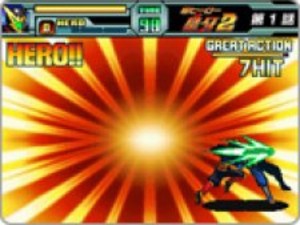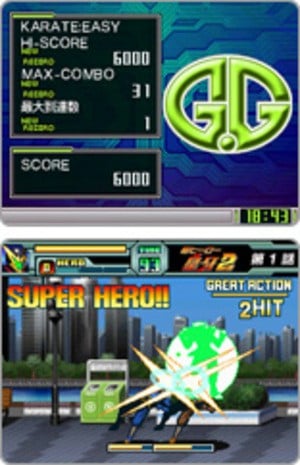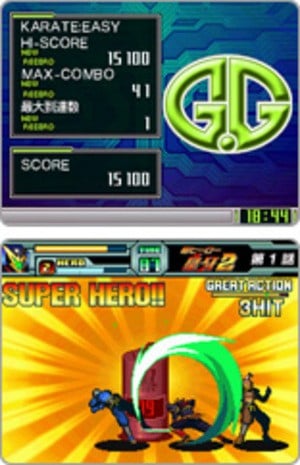
Having collected the first wave of G.G Series titles, Genterprise and Suzak have decided to go back to the well and release their sequels. As with ZONE 2, Chō Hero Ōga 2 takes the fundamentals of the original and extends them whilst maintaining the same level of fun. The transition is not unlike moving from early arcade games to those of the late 1980s onwards, with the addition of extra abilities and a more fleshed-out presentation in this follow-up to what will be known in the west as Super Hero Ogre.
Though the structure of the play area is broadly the same, there's now interstitial story bits showing your costumed alter-ego moving from location to location and chatting with an associate, the scenery changing to give the impression of a journey to face the moment's big baddie. You're fighting pretty much the same henchmen/robots/whatever those weirdoes with the antennas coming out of the top of their heads are – and facing off against a boss after defeating three stages of cannon fodder, only now there's text-based dialogue and additional objectives to mix things up a bit.
There are less of the low-level enemies than we recall from the first adventure, and the fact that you continue off of the right edge of the screen before an cut scene that shows you running to the next area gives a real sense of momentum to the action. The second stage features a bomb that needs to be destroyed (failing just means missing out on bonus points) and the third introduces a new over-sized sub-boss enemy type who has a vulnerable spot highlighted in a bit of dialogue with your sidekick/operator at the stage opening. The fourth level is the boss fight, and it's here that another difference between this game and its predecessor becomes apparent – it's a lot harder.

None of the G.G Series games have been particularly easy, but this is certainly one of the more challenging ones, despite the provision of extra controls and powers. All four primary face buttons on the DSi are used now: in addition to low-power attacks and power attacks, you have two extra buttons to bring into play. One will expend a third of your power meter with an energy burst that looks like a shield but actually blasts away nearby enemies – great for when you're surrounded by Cyclopses in colourful costumes. The other is used to trigger a special state when your meter is at maximum, allowing you to pull off a succession of more powerful attacks until it runs out. The nature of these depends upon which technique you chose when you started the game: Kendo sees the hero making slow, powerful swipes with an energy sword, whilst Karate allows for rapid-fire execution of the usual power attacks and a more devastating version of the flying kick.
Getting to grips with these abilities and learning when to use them is key to progressing. Whilst ploughing through the regular baddies isn't too hard, you'll want to avoid getting hurt before facing off against the bosses because they're a lot tougher and have special moves of their own. Also, your health only regenerates after their defeat before starting on the road to the next. If you fail, you can choose to retry, though this will just stick you right back at the beginning – it's only if you progress to the next set of stages that you can properly continue.
Visually this is quite an impressive game which looks terrific on the larger screens of our DSi LL. The three stages before the boss fight take place outside with a sharply-detailed city skyline in the background and parallax scrolling to give a little depth to the otherwise solidly 2D game environment.

Following ZONE 2's lead, there's two additional difficulty levels to unlock, though we have to say that calling the initially available level "Easy" is very much a misnomer, and it's not clear how many supervillians you need to defeat to unlock "Normal" difficulty. Also like ZONE 2 and later games in the original G.G Series run, you can completely remap the buttons, which we did promptly. High scores are tracked by difficulty and special power attack (Kendo or Karate). Also indicated is the highest combo level reached, a number that increases by your using normal attacks to "juggle" opponents. When an enemy isn't being hit, a combo meter quickly runs down; if you manage to land another blow before it hits empty, the combo is extended. We managed 81 with Kendo and 86 with Karate. How about you?
G.G Series Chō Hero Ōga and its sequel present a different enough kind of play style so that one doesn't make the other redundant, so hopefully Genterprise will see fit to treat overseas players to the newest entries in their seemingly never-ending series of retro arcade gems.
Comments 2
looks phenomenal--can't wait to give it a go. GG series is gg.
Hopefully the first super hero oga will prepare me for this because this sounds hard and I haven't played many games like this.
Show Comments
Leave A Comment
Hold on there, you need to login to post a comment...